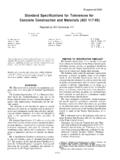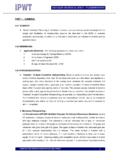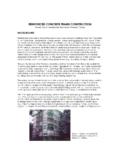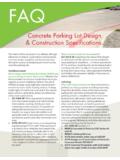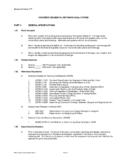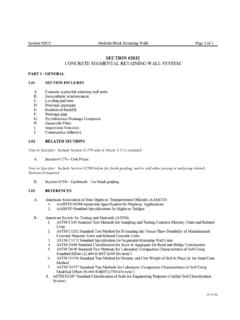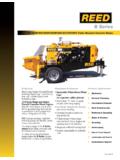Transcription of Canadian Farm Builders Association
1 Canadian farm Builders Association Guidelines for concrete Specifications Class of concrete Maximum W/CM Minimum 28 Day Strength (MPa) Air Content & Category concrete Application C 1 35 5 8% (Table 10) Structurally reinforced concrete exposed to severe manure and/or silage gases - with or without freeze/thaw exposure HPC concrete recommended in these applications. Examples: Reinforced beams, slabs and columns over manure pits and silos, canals, pig slats C - 2 32 5 8% (Table 10) Structurally reinforced concrete exposed to moderate to severe manure and/or silage gases & liquids - with or without freeze/thaw exposure. Examples: Reinforced walls in exterior manure tanks, silos, and feed bunkers, exterior slabs. C 3 30 4 7% (Table 10) Structurally reinforced concrete exposed to moderate manure and/or silage gases & liquids - without freeze/thaw exposure or concrete in a continuously submerged condition.
2 Examples: Interior gutter walls, beams, slabs and columns. C 4 25 4 7% (Table 10) Non-Structurally reinforced concrete exposed to moderate manure and/or silage gases & liquids - without freeze/thaw action. Examples: Interior slabs on grade. N Structural Structural (Note 5) __ concrete not exposed to agricultural waste products or freeze/thaw action Examples: Footings and interior walls, beams, columns and slabs not exposed to agricultural wastes, chemicals or freeze/thaw action. HPC < By Engineer (Table 10) concrete to greatly improve durability and permeability. HPC concretes should be developed with the concrete Producer to meet the Engineer s specification requirements and the Contractor s workability needs. Notes: 1) The Engineer shall specify exposure conditions and concrete applications. 2) concrete shall be supplied by a concrete producer in the possession of a valid Certificate of concrete Facilities as issued by the Ready Mixed concrete Association of Ontario (RMCAO) 3) CSA A231.
3 Clause provides additional information regarding the special provisions required to improve the durability of concrete exposed to aggressive chemicals, fertilizers and agricultural wastes. 4) In agricultural applications Type 20 or Type 50 Sulphate Resistant concrete may be recommended (CSA Table 12) 5) For all type N classes of concrete in agricultural applications a minimum 25 MPa, W/CM concrete is recommended. Verify with the Engineer. 6) Both interior and exterior concrete slabs typically only require a broom finish to provide slip-resistance. 7) The use of chemical admixtures such as Superplasticizers can increase flow and decrease permeability. In all cases, the maximum water cement ratio should not be exceeded. Reference Canadian Standards Association CSA concrete Materials and Methods of Construction, Methods of Test for concrete 1 CFBA Agricultural concrete Cover Guidelines Exposure Condition and Class of concrete Not Exposed* N Severe to Moderate Liquid Manure Exposure C 3, C - 4 Very Severe to Severe Manure Gases Exposure C 1, C 2 Cast against and permanently exposed to earth N/A 75 mm 75 mm Beams, girders, columns and piles 30 mm 40 mm 60 mm Slabs, walls, joists.
4 Shells and plates 20 mm 40 mm 60 mm Ratio of cover to nominal bar diameter Ratio of cover to nominal maximum aggregate size *This refers only to concrete that will be continually dry within the conditioned space, , members entirely within the vapour barrier of the building envelope. The cover for a bundle of bars shall be the same as that for a single bar with an equivalent area. The specified cover from screeded surfaces shall be at least times the nominal maximum aggregate size to reduce interference between aggregate and reinforcement where variations in bar placement result in a cover smaller than specified. Note: Greater cover or protective coatings may be required for exposure to industrial chemicals, food processing, and other corrosive materials.
5 See Effects of Substances on concrete and Guide to Protective Treatments, IS001, Portland Cement Association , 1997. Requirements for the Air Content Categories CSA Table 10 Range in air content* for concretes with indicated nominal maximum sizes of coarse aggregate, % Air content category 10 mm 14-20 mm 28-40 mm 1 6-9 5-8 4-7 2 5-8 4-7 3-6 *At the point of discharge from the delivery equipment, unless otherwise specified.
6 1 - concrete exposed to freezing and thawing 2 - concrete not exposed to freezing and thawing Note: Air contents measured after pumping or slip forming may be significantly lower than those measured at the end of the chute. Types of Ready Mixed concrete Performance Type Application Normal CSA Classes of Exposure, Air or Non-Air Entrained, specified strength gains, integral color, fibres etc Delay Set Same as Normal with specified Delayed Set time Standard Accelerated Set Same as Normal with specified Accelerated Set time High Performance concrete (HPC) Special requirements for: Self-consolidation/Self-Compacting Chemical Attack* Durability Structural Permeability *Note: In agricultural applications with sulphate exposure - Type 20 or Type 50 concrete is recommended 2 All Information contained herein is designed to act as a guideline only. 3 CFBA Quality Control The information below is a condensed form of portions of CSA ( concrete Materials and Methods of Construction) and applies to all buildings constructed under the Ontario Building Code.
7 Please refer to the actual standard for a full description of requirements. concrete Quality All concrete materials and methods of construction shall conform to CSA This shall include methods of testing the concrete for quality control as outline in Section 17. The administrator of the requirements of this Standard shall be the owner or the designated representative, usually a professional engineer or an architect. General Evaluation of concrete quality to ensure performance to the requirements of this Standard shall be the responsibility of the owner. Unlimited access to the work for the purposes of inspection and selection of samples shall be available to the owner at all times. The owner shall be responsible for reviewing all test reports to ensure the requirements of this Standard have been met. Sampling concrete - Samples of concrete for testing purposes shall be secured in accordance with CSA Test Method When the owner desires to assess the quality of concrete at a location other than the point of discharge from the delivery equipment, the owner shall state the point from which the samples shall be taken.
8 Compressive Strength - The compressive strength shall be determined in accordance with additional Clauses in this Standard. For standard strength tests, 100 x 200 mm cylinders shall be used. Not less than one strength test shall be made for each 100 cubic meters of concrete placed, and in no case shall there be fewer than one test for each class of concrete , as designated by the owner, placed on any one day. When the frequency of testing stipulated above will provide fewer than three tests for a given class of concrete , tests shall be made from at least three randomly selected batches on a single project. Air Content of Fresh concrete - Where concrete will be subjected to frequent cycles of freezing and thawing in the presence of moisture or de-icing chemicals, every load or batch shall be tested until satisfactory control of the air content is established and fewer tests are required by the owner.
9 Slump - A sufficient number of tests shall be made to ensure uniform slump of the concrete . A slump test shall be made with every strength test and every second air test. Temperature of Fresh concrete - ASTM 1064 The temperature of fresh concrete shall be measured with every strength test. Curing and Protection 1) Curing and protection of concrete shall conform to CSA Section 21. 2) Curing shall begin immediately following the placing and finishing operations and shall provide the temperature and moisture conditions for the period of time necessary for concrete to develop its strength, durability, and other properties. 3) Freshly deposited concrete shall be protected from freezing, abnormally high temperatures, premature drying, and moisture loss. concrete surfaces shall be cured for either 3 days at a minimum temperature of 10 C or for the time necessary to attain 40% of the specified 28 day compressive strength.
10 4) Curing of exposed surfaces shall be achieved by one of the following methods: - ponding, continuous sprinklering or vapor mist bath - plastic film or waterproof paper - absorptive mat or fabric kept continuously wet - forms in contact with concrete surface - curing compounds spray or roll-on - or other methods as approved by the owner
